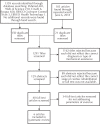Exercise guidelines for inpatients following ventricular assist device placement: a systematic review of the literature
- PMID: 23801903
- PMCID: PMC3691707
Exercise guidelines for inpatients following ventricular assist device placement: a systematic review of the literature
Abstract
Background: For patients with end-stage heart failure awaiting transplantation, lack of donor organs has created an increased need for alternatives such as left ventricular assist device (LVAD) implantation. The purpose of this study is to determine safe and effective exercise parameters for physical therapy in the acute care setting.
Methods: A systematic literature review was conducted according to PRISMA guidelines using Sackett's Levels of Evidence to rate the evidence. Multiple databases were searched with inclusion criteria of: available in English, inpatient care up to 6 months postoperatively, description of intervention type and exercise parameters.
Exclusion criteria: no defined exercise parameters, outpatient treatment, infection post VAD, or palliative or hospice care post VAD.
Results: Six studies out of 1,291 articles met inclusion criteria. Common exercise parameters used were the Borg Rating of Perceived Exertion scale 11-13 (6-20 scale) or > 4 (0-10 scale), Dyspnea scale > 2 (0-4 scale) and > 5 (0-10 scale), mean arterial pressure (MAP) 70-95 mmHg, and LVAD flow > 3L/min. Levels of evidence ranged from case controlled to expert opinion.
Conclusion: Current evidence on inpatient exercise parameters for patient's status post LVAD implantation is not sufficient to suggest definitive guidelines; however, these exercise parameters provide a reference for patient care.
Keywords: exercise; physical therapy; ventricular assist device.
References
-
- Nissinoff J, Tian F, Therattil M, Salvarrey RM, Lee SW. Acute inpatient rehabilitation after left ventricular assist device implantation for congestive heart failure. PM R. 2011;3((6)):586–589. - PubMed
-
- Rose EA, Gelijns AC, Moskowitz AJ, et al., editors. Long-term use of a left ventricular assist device for end-stage heart failure. N Engl J Med. 2001;345((20)):1435–1443. - PubMed
-
- Salzberg S, Lachat M, Zund G, et al., editors. Left ventricular assist device as bridge to heart transplantation - Lessons learned with the MicroMed DeBakey axial blood flow pump. Eur J Cardiothorac Surg. 2003;24:113–118. - PubMed
-
- Baughman KL, Jarcho JA. Bridge to life-cardiac mechanical support. N Engl J Med. 2007;357:846–849. - PubMed
-
- Miller LW, Pagani FD, Russel SD, et al., editors. Use of continuous-flow device in patients awaiting heart transplantation. N Engl J Med. 2007;357:885–896. - PubMed
LinkOut - more resources
Full Text Sources
Miscellaneous

